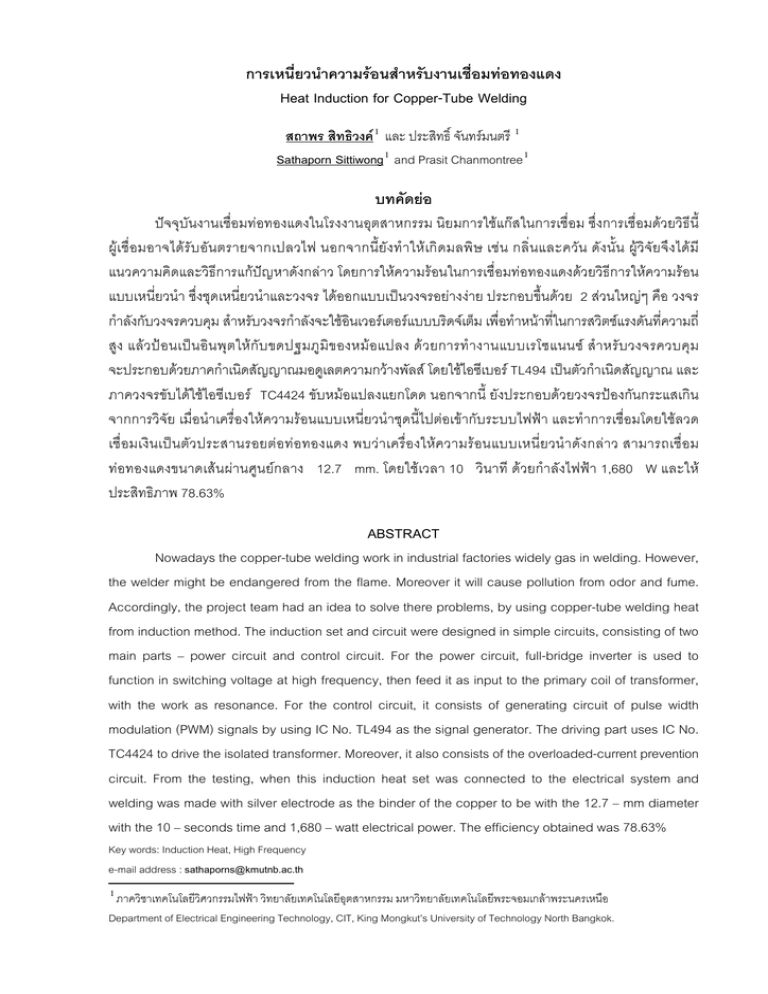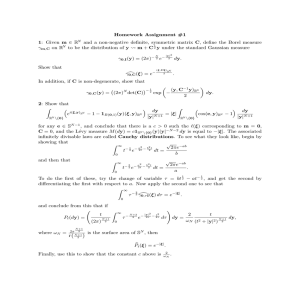F F Heat Induction for Copper
advertisement

Heat Induction for Copper-Tube Welding 01 232 4 1 1 Sathaporn Sittiwong 1 and Prasit Chanmontree 1 !"#$%&'()*))#+#,-##$)!$./ 0/$,&1/2,/$%&'() 34(#/$%&'()+1505 6 781% &'( ) )$9+1 " ) $0$/%59: )/$/60 # ; $,.1 %/ + < = %&* /( >5 + # 6 781 5 0 4 # 9+1 5>5$>+5 /$/1?.$+#/*$5 -+0/$,.1>5$1),/$%&'()*))#+#+1505 /$,.1>5$1) ""%.(05;$ 34(#&!+%.(05;$5# 9+1))/""%@5#)0*$##*$0 /)"A46+150 2 *5,.?*C >') 5# /;$#/"5#>5">! ;$."5#/;$#,&1)%5)%)"""+%D %<'();$.1$(,/$5&#+>( 5$E( 8# 15F ) %@ ) <! ,.1 / " A+GH8 A )#.1 )# +1 50/$; $#$""%-33 ;$. "5#>5">! /)"+150H$>/;$%+??$I)+8%>5$/51$#< -+0,&19)3%") TL494 %@5/;$%+??$I H$>5#A"9+1,&19)3%") TC4424 A".1)#0/-++ )/$/6 0#/)"+1505#F)#//%/ $//$50 %'();$%>'()#,.1>5$1)""%.(05;$&!+69*)%A1$/"""9::F$ ;$/$%&'()-+0,&15+ %&'( ) %# %@ 5$)0* ) * ) )#+# <"5* $%>'() #,.1 > 5$1 ) ""%.( 0 5; $+ # /*$5 $$E%&'( ) *))#+#A$+%17*$N80/$# 12.7 mm. -+0,&1%5$ 10 5$ +150/;$#9::F$ 1,680 W ,.1 H$< 78.63% ABSTRACT Nowadays the copper-tube welding work in industrial factories widely gas in welding. However, the welder might be endangered from the flame. Moreover it will cause pollution from odor and fume. Accordingly, the project team had an idea to solve there problems, by using copper-tube welding heat from induction method. The induction set and circuit were designed in simple circuits, consisting of two main parts j power circuit and control circuit. For the power circuit, full-bridge inverter is used to function in switching voltage at high frequency, then feed it as input to the primary coil of transformer, with the work as resonance. For the control circuit, it consists of generating circuit of pulse width modulation (PWM) signals by using IC No. TL494 as the signal generator. The driving part uses IC No. TC4424 to drive the isolated transformer. Moreover, it also consists of the overloaded-current prevention circuit. From the testing, when this induction heat set was connected to the electrical system and welding was made with silver electrode as the binder of the copper to be with the 12.7 j mm diameter with the 10 j seconds time and 1,680 j watt electrical power. The efficiency obtained was 78.63% Key words: Induction Heat, High Frequency e-mail address : sathaporns@kmutnb.ac.th H$>5&$%>--05N5/9::F$ 50$0%>--0)!$./ .$50$0%>--0<)%/1$<>%.') Department of Electrical Engineering Technology, CIT, King Mongkutts University of Technology North Bangkok. 1 ,!"6 #$)!$./%&'()*))#+#,-##$%>'()#;$>5$%0D 9+1/$<w$$)+ 34(# *5,.?*,.1>5$1)+1505 ,&1%59:$//D*&6#$(9+10#>!IH$<(;$ )/$/6 0#;$,.1%/+H$5 %&*/(>5$/ )$*#7/*),.1%/+)$0,"$#E$(9+1 %&* -/+#%/D"5+!%>HIx<'6((,&1;$." 7.')/)")$.$ %@1 +#6 4#%.D>5/1?.$%.*$6 -+0/$,&1%>'()#,.1>5$1)""%.(05;$ E4#15*$>'()#,.1>5$1)""5 %.(05;$ $$E 7A46H$0,%N9+115 *)!/I"$#)0*$#( ,&1/)"%@5%>'()# 0#1)#;$%A1$$$/*$#%N $>$>*)A1$#8# %<$y6 4#1)#/$N4/=$ <w$%<'()9+1%>'()#%&'()""%.(05;$>5$1);$."/$%&'()$*))#+# (,&15+!)!/I /)"H$0,%N %<'();$,.11!(;$ A$+%D/# * H$</$,&1#$8#A46 @ABCD 1.@ABF $//$N4/=$A)# Foucault Heaviside [1,6] 34(#9+1+)#%/(05/"/9.5(Eddy Current) /$0%@!+%(1A)#/$%.(05;$>5$1) +1505 *$#C / ,%5$*)$ Heaviside 9+1%A0%@ ">5$ &'() |The Induction of Current Core} 34(#%@">5$(%A0A46 %/(05/"/$E*$0>5$1)$/A+5+ 90#*#-. )$$0$0& &!+%') ;$50 %>'()#,.1>5$1)""%.(05;$;$."#$%&'()$*) )#+#" 9+1"!50$/ ;$/#$>I//$50.*#&$ (5&.) 2553 #$50+#/*$5 ))/"""" >5">!-+0,&19->>)-%) ;$,.1%/+>5$0!*#0$//"781(9*<'6>5$81+1$9->>)-%) 781504# >+))/""5#>5">!)0*$##*$0-+0,&19)3/;$%+??$I PWM ;$%D8(,&1#$#*$0$>$E8/;$,.1/$ 1$#9*%/+>5$0!*#0$/ %'()#$//$,.1 >5$1)+1505 /$%.(05;$ 9*1)#/$%&'6)%<#$/.*#H$0)/ +#6 ;$,.1 >*$/$8?%0>*$1)0 &6#$)$+ %<$9**5,+7//".*#>5$1) 4#;$,.1=%/(05/" /$%.(05;$>5$1) 9+1"/$<w$)0*$#*)%'()# ;$.".//$%"'6)#1A)#/$%.(05;$>5$1) %.')/".//$.1)# >')>5$< A)#/+1$A+!0H8 >*$%*$/" Is %'() Is Ip Ns Np = Ip Np Ns (1) /+1$A+!0H8 (A) /+1$A+GH8 (A) ;$5)"A+5+A+!0H8 (turn) ;$5)"A+5+A+GH8 (turn) * E1$;$5)"A+5+$#+1$A+! 0H8 Ns % <0 #)"%+0 5.') % 0"%') /" + 5# +#,H$<( 1 +#6 >5$< A)#/+1$A+!0H8 >*$%*$/" Is = Ip Np (2) H$<( 1 A+5+!0H8)"%+05.')E8/+5# $//$( (2) <"5*$ /-.+>*$7#/"/(A+GH8 ;$5)"A+5+ +1$A+GH8 H$<( 2(a) %@/$+#A+5+;$.",.1>5$1)/"-.+(%@*)-.)#+#8#/")/ H$<(+#+#/*$5%0"%')/"5#.1)#A)#H$<( 1 -+0A+5++1$GH8E8/<.$0)" *A+5++1$!0H8E8/+5# (*))#+#) .')%0"%')<)"%+05 <1)/"&*)#)$/$N%D/C 0/.5*$#A+GH8/"&6#$ 34(#/I61)#>;$4#E4#>*$A)#/$/;$/"75 (Skin Effect) A)#>5$ .$*/%.(05;$(>5$E(8#C +150 %'()#$/ >*$>5$.$*/%.(05;$(%/+A46/"75*)-.#/")/ >*$+#$0 >5$4/A)#75 E1$.$/>5$E(>*$8#A46 )$/$+#A)#/+#/*$5 /D>*$%<(A46$ )/$/6 0#1)#>*$A46)08*/">*$>5$1$$;$%<$ >*$>5$343$"A)#$*%.D/A)#*)-.#/")/ )/+150 H$<( 2(b) +#<'675*)-.)#+##/")/ (7*))/%@7* ,.1)#%')+5#$# A+!0H8951 >*$>5$1$$A)#*)-.#/")/>*$A46)08*/"A$+ ;$."/=I/$9.A)#/ )#%.' ) 9."7* $"A)#7 5* ) -.#/")/%&* / 5 E! #> . / %<'( ) +< # #$( F ) 7($$ >') ;$,.1>*$/$8?%0,*)#/")/56#A+5+>*$+# ;$,.19+1 H$<>*$8#!+ )/+150 l d d ac (a) (b) H$<( 2 A+5+(,.1>5$1)/"-.)#+#8#/")/ η 1 = 1+ %'() η ρ c ρ w µ w ρc [2] (3) ρw × µw >') H$</$,.1>5$1) >') >*$>5$1$$;$%<$A)#A+5+ (Ω-cm) >') >*$>5$1$$;$%<$A)#*)#/")/ (Ω-cm) >') >*$>5$343$"$*%.D/A)#*)#/")/ -+0$//$ H$<$#)!+> <"5*$E1$.$/>*$>5$1$$;$%<$A)#8*)#/")/ .' ) ρw / ">* $>5$34 3$"$* %.D/ A)#*) #/")/.' ) µw >* $8 #$/C >* $ H$< >* $ %/')" 100% %'( ) #$/>* $ >5$.$* A)#/ (J) ( 9 +1 $//$%.( 0 5; $ /$/A+5+ (coil) 90 # ( 7 5&6 #$+1 500>5$4 / ,8 %)D / -<%%& 0 (Exponential) <1 ) / " /; $.+,.1 % @ >* $>5$34 4 / 7 5 (Skin Effect) -+0E1$>5$E(A)#.*#*$0>*$8#C >*$>5$344/75+#/*$5/D+# <1)/"9+1/9." <'675A)#&6#$$/E1$8#&6#$/=I""7*%0">5$.$*A)#/,&6#$6 9+1 %*$/"/$ -x J = J0e /δ [2] (4) %'() J >') >*$>5$.$*A)#/(0 x ,+C $/75 (cm) J0 >') >*$>5$.$*A)#/(75 (cm) f >') >5$E(.*#*$0 (Hz) δ >') >*$>5$344/75 34(#%*$/" ρ x 109 δ = 1 c 2π µw f [2] (5) $//$( (4) )$*5>*$>5$.$*A)#/(0 x ,+C*)>*$>5$.$*A)#/ $/75AI/;$/")$*50 x *)>*$>5$344/75 δ .') J/J0 = f [x/δ] 9+1$H$<( 3 $/H$<( 3 %.D5*$>*$>5$.$*A)#/%.(05;$(0 x (>*$%*$/" δ >*$%*$/" 0.368 %*$A)#>*$>5$.$*A)#/(75 H$<( 3 )$*5A)# J/J0 AI/;$/")$ x/δ $//$( (5) <"5*$E1$.$//$,.1>5$1)/"&6#$+150>5$E(*$#/%@7;$,.1>*$>5$34 4/75 (δ) *$#/+150 %&* %'()>5$E(>*$(;$ >*$>5$344/75>*$8# +#64#%.$;$."/$,.1>5$1) /"&6#$6#&6 .')E1$.$/%@>5$E(8# >*$>5$344/75>*$(;$ +#6 %.$/"&6#$(1)#/$&!" AD#("%5I75 ;$."A1)+A)#/$,.1>5$1)+150>5$E(8# 2. 232 2.1 N4/=$$0%)0+ (Specification) $G$>5$)+H0A)#&!+,.1>5$1)%.(05;$*$#C 2.2 /$))/"" 1$# +)# %/D"A1)8 5%>$.7 /$))/""5#781509+1))/""%<'();$9,&1#$%&'()*))#+#A$+ φ 9*%/ 12.7 mm. .$9*%/ 1.5 mm. +150.*#*$0/;$#)<!%:%+05 220 V, 50 Hz %)$<! 3 kW (>5$E( 26 kHz 5#.//)"A46+150 2 *5 >') 5#%0#//"5#)%5)%) ;$."5#)%5)%) /)"A46+1505#/;$# -+09+1,&1)%:/;$#%@)!/I/$5&9)3 TL494 ;$.1$(7 ??$I PWM +#+#,H$<( 4 <1)/" TC4424 ;$.1$(&!+A";$%/ +#+#,H$<( 5 )/$/65# 0#/)"+150&!+F)#//5#.*#*$0/;$#&*50 +#+#,H$<( 6 + 12 V 1N 914 + 12 V VR 12 V + 12 V 8 1N914 3 1. 5 k 4 1N 914 4. 7 k 8 LM358 14 REF E1 1 9 12 V 10 k E1 2 VDD IN A OUT A 5 1N 914 12 V OUT A 1IN- 1k + 12 V FB 1 100 nF 4. 7 k E2 3 1 nF 10 k E2 2 RT 1IN+ 2IN+ CT GND 16 7 5 GND 10 IN B OUT B 7 IN B OUT B G2 4.7 12 V O/ P CTRL 1M 1k 15 14 IN A 4 1. 5 k LED S1 13 13 2 S1 C1 DTA 11 12 C2 VCC 15 2IN- G1 4.7 S2 5 11 1N 914 G3 10 12 V 4.7 5 12 V 6 S3 GND 4 1 nF 1N 914 12 V G4 4.7 100 12 V H$<( 4 +#5#1$#??$I PWM S4 H$<( 5 +#5#A";$%/+1509)3%") TC4424 H$<( 6 +#5#F)#//5#.*#*$0/;$#&*50 781509+1))/""$$E,&1#$9+1/"&6#$A$+A$+%17*$N80/$#8#!+ 15 mm. &6 #$%@ *))#+#(,&1,""%>'()#")$/$N>*$>5$1$$;$%<$A)#*)#/")/ ( ρw ) ()!I.H8 30 OC >') 1.682 µΩ − cm. >*$ Relative Permeability .') µ / µ0 ( µ w ) = 0.999994 ))/"",.1>*$>5$ 1$$;$%<$A)#A+5+ ( ρc ) 0.05 ρw %'()>*$,/$ (3) 9+1 H$<>5$1)%*$/" 81.76% HCCCD 2IJ4 781509+1;$/$+)#""1"" -+0F)%A1$/"#+.*#*$0/;$# 220 V 50 Hz <1)/";$ /$%&'()*))#+# 2 A$+ >') A$+%17*$N80/$# 9.52 mm. /" 12.7 mm. (%')/A$++#/*$5 %<$ %@ A$+( 0 ; $ ,&1 # $,-##$)! $./%>'( ) #; $>5$%0D <"5* $$$E%&'( ) * ) )#+#A$+ %17*$N80/$# 9.52 mm. 12.7 mm. 9+1# -+0,&1%5$ 10 s +#$0%)0+$$$#( 1 $/A1)8$$$#( 1 %'();$$<D)%@/$:)!I.H8 T = f(t) 9+1$H$<( 7 <"5*$ *))#+#A$+%17*$N80/$# 12.57 mm. 9+1")!I.H88#/5*$ *))#+#(A$+%17*$N80/$# 9.52 mm. 6#6%'()#$/75A)#*)A$+%17*$N80/$# 12.7 mm. 0.*$#$/75A)#A+5+%.(05;$ >5$1)1)0/5*$ %'()%0"/"75*)A$+ 9.52 mm. +#6 4#">5$1)9+1+/5*$ ;$."/;$#9::F$(F) 781509+1;$/$+)#/"*))#+#A$+ 12.7 mm. +1505%*$/" 50 g. ,&1/;$#)<! %*$/" 1,680 W. %'();$5)#+#+#/*$5%*$/" 50 g. )!I.H8(%(0#%*$/" 680 OC >*$>5$1);$%<$)#+# %*$/" 0.093 cal/g OC %5$(,&1 10 s 9>;$5I/;$#%)$<!>*$(9+1>*$%*$/" 1,321 W +#6 H$<%*$/" 78.63% %.D5*$>*$(;$/5*$>*$())/"">;$5I951%D/1)0%'()#$/%/+/$8?%0, )!/I)%D/)//;$#(,&1,/$53 $$#( 1 A1)8(9+1$//$+)# >5$E( (kHz) %5$ )!I.H8*))#+# (OC) (s) φ 9.525 mm φ 12.7 mm 0 30 30 2 70 77 26 4 180 198 6 310 340 8 523 550 10 668 692 $/H$<( 8 %@/$,.1>5$1)%<'()%&'())#+# -+0(/$%.(05;$%/+A46(A5+5+;$,.1%/+ >5$1)(*))0*)A)#)#+# ( C) H$<( 7 /$: T = f(t) H$<( 8 AI,.1>5$1)%<'()%&'()*))#+# KL $/7A)#/$+)# <"5* $ %>'( ) #,.1 > 5$1 ) ""%.( 0 5; $ $$E%&'( ) * ) )#+#A$+ φ 9.52 mm. /" 12.7 mm. 9+1 H$0,%5$9*%/ 10 s 9+1 H$< 78.63% +#6 4#>5$+5/ *),&1#$ %<$A$+%D/ 6;$./%"$,&1%5$/$%0#$/*)/$%&'()1)0 )/$/6>5$1)(%/+ A46/"&6#$ %/+A46)0*$#(;$%))"*))#+#<1)/ 34(#*$#//"/$%&'()/D(1)#,.1>5$1) ""!+ A1);$/+E$(,/$,&1#$ %&* 781%&'())$9+1")$0$/%59:+150 /$%/+%5 9:+#/*$5 0#%@7;$,.1%/+<=$#)$/$N %&* /( >5 -+0%y<$.1)#)+! (Clean Room) ,-#<0$"$.') E$(/)")$.$ %@1 )/6#5#(,&1%@5#)0*$##*$0 )!/I.$3'6)9+1#*$0$ 1)#$+$>$E8/ $$E1$#A46,&19+1%)# [1] [2] [3] [4] [5] [6] 2 Heavisde, O.1884. The induction of currents in cores, pp. 583. In The Electrician.May 1884. John Davies, Peter Simpson.1979. Induction Heat Hand Book McGraw-Hill, New York, 1979. John F.rider.1988. Basic of Induction Heating. New York : Publisher,inc, 1988. Muhammad H. Rashid.1998. Power Electronics. New Jersey : Prentice-Hall International, 1998. S. Zinn and S.L. Semiatin.1988. Elements of induction heating In design, control, and applications. Metals Park, Ohio, c1988. Thomson, J. J. 1892. On the heat produced by eddy current in an iron plate exposed to an alternating magnetic field. In The Electrician, April 1892.




